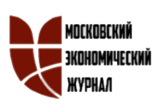
УДК: [338.246.2:001.895] = 111
DOI 10.24411/2413-046Х-2019-14008
Innovations and prospects for the innovative development of the economy in the Russian Federation
Mogilevich Ekaterina, Semenov Dmitriy, Financial University under the Government of the Russian Federation, Moscow
Scientific advisor, Senior teacher Moiseeva T.V.
Summary: The article reveals the essence of innovation performance and its economic implications which ensure a long-term steady growth of the nation’s welfare, labor productivity, as well as the country’s success in competing for major positions in global markets, as well as the necessary factors for ensuring and implementing the economic growth, creating favorable environment conditions to innovation and correcting prioritization by areas of innovation policy support.
Key words: innovation policy, innovation potential, labor productivity, employment, human capital, innovation pyramid, capital-labor ratio, economic growth, economic well-being, technological development.
The economic theory contains many fundamental works which show that long-term economic growth is determined not only by an increase in production factors, but also by technological innovations. Based on these works, four main levers of influence on the long-term growth (15-20 years) of economic well-being can be identified: the growth of employment; innovation (productivity growth); improving the quality of labor (increase in labor productivity); growth of capital-labor ratio (increase in labor productivity). The term “innovation” comes from the Latin “novatio”, which means “update” (or “change”), and the prefix “in”, which is translated from Latin as “in the direction”, if translated literally. [1, P. 231.]
“Innovatio” – “towards change”. The concept of “innovation” first appeared in nineteenth-century research. The concept of “innovation” received a new life in the beginning of the XX century in the scientific works of the Austrian and American economist J. Schumpeter as a result of the analysis of “innovative combinations”, changes in the development of economic systems. Schumpeter was one of the first scientists who, in the 1900s. put this term into scientific use in economics. Innovation is not any innovation, but only one that seriously increases the efficiency of the current system. Now innovations are the main possible levers of influence on the long-term growth of economic well-being for Russia, since it is possible for three other of the four available to be significantly limited: for employment – there is a rapid decline in the number of working-age population; for the quality of the workforce – a deterioration of the situation is predicted as a result of a weak state policy, for capital-labor ratio – because of an outflow of capital, there is no stock on the level of capacity utilization of the economy. The possibility of long-term economic growth through innovations, especially in the countries that are not leaders in innovations, has long been noted in the economic theory and confirmed by macroeconomic data for Russia, China and South Korea over the past 20 years.
The main levers of growth of economic well-being. Economic theory contains many fundamental works showing that a long-term economic growth is determined not only by an increase in production factors, but also by technological innovations. A longer-term growth in economic well-being, measured as GDP growth per capita, is determined in more detail by two factors (see Fig. 1): employment growth and productivity growth. In turn, the growth of labor productivity, based on the model of a long-term growth R. Solow (1957), consists of three components: the growth of total factor productivity (Total factor productivity, then TFP is a widely accepted paradigm for estimating and forecasting long-term production dynamics) as changes in TFP reflect changes in GDP that are not explained by changes in production factors); the growth of the quality of the workforce (worker skills); growth of capital-labor ratio (available capital per employee). The change in total factor productivity is calculated as a change in GDP, not explained by changes in the factors of production (labor and capital), and in the long-term horizon is mainly due to innovations.
So, based on the factors determining the growth of well-being, and the ability to influence their changes, we can distinguish four main levers of influence on the long-term growth of economic well-being (see Fig. 1): the growth of employment; innovation (productivity growth); improving the quality of labor (increase in labor productivity); growth of capital-labor ratio (increase in labor productivity).
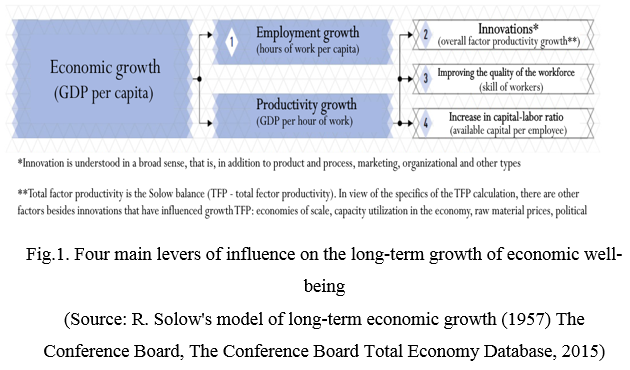
Sources of growth of economic well-being in Russia. Let us consider in more detail the current possibilities of enhancing the economic well-being for Russia. The first lever – the growth of employment of the population – is not able to provide a significant increase in economic well-being due to the current and projected dynamics of demographic indicators. Thus, the number of working-age population is rapidly decreasing since 2006, and it is projected that by 2020 it will be 80.6 million people, which is about 10 million less than in 2006. [2; p 561] The other three levers – innovation, quality of work force and capital-labor ratio – directly increase the productivity. Let’s look at the dynamics and absolute levels of this indicator in Russia and developed countries. Labor productivity in Russia, having shown a significant increase (by 60%) from 2000 to 2014, has practically not increased in the last three years (see Fig. 2). At the same time, the lag of Russia in labor productivity from most developed countries remains substantial. Thus, the average labor productivity in the first ten of the leading countries in this indicator is 2.8 times more than in Russia.
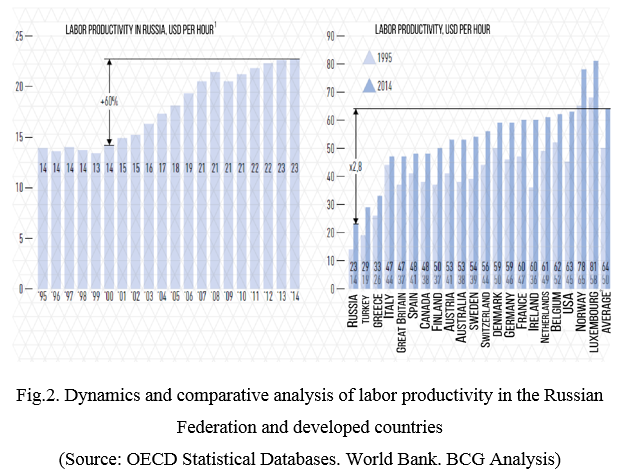
A significant lag in the labor productivity is observed in all sectors, with the exception of the extractive sector of the economy (see Fig. 3). Particular attention should be paid to the fact that high-tech products, being the main driver of high performance in developed countries, are the most problematic industries for Russia.
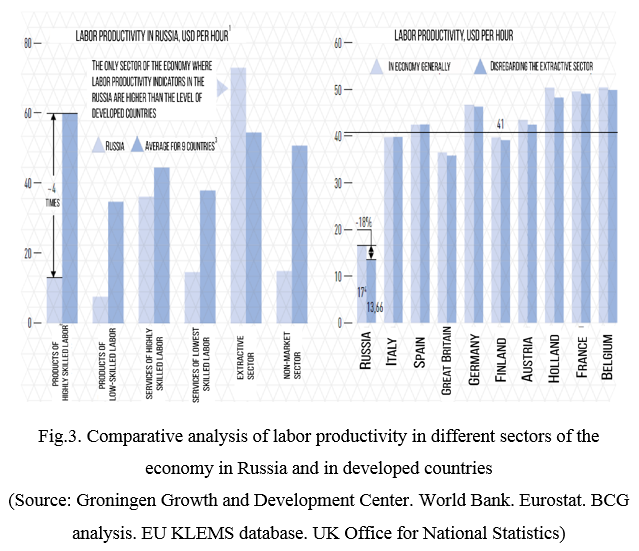
The third lever – improving the quality of labor – is unlikely to be the source of a significant increase in the labor productivity due to the significant inertia and moderate dynamics of this indicator in the past few years. The main factors determining the quality of the workforce are the education and experience of the working population. Weak state policies in the field of education in the 1990s and the impossibility of completely replacing the retiring experienced working-age population only worsen the forecast for the dynamics of the quality of the labor force in Russia.
The fourth lever – an increase in the capital-to-use ratio – also does not help to reduce a significant gap in the labor productivity, because the net capital outflow since 2008 is in the range of 2–4% of GDP, or 10–20% of the annual capital investment in economics [8; P.342-343]; the financial ability to support investments by the state is significantly limited (for example, the total amount of the Reserve Fund and the National Wealth Fund is 23% of the annual volume of annual capital investments in the economy) [4, P.282]; capacity utilization in the economy is approximately 67%, which is very close to the maximum value over the past 20 years, equal to 73% (estimated, the load in a normal operation can be up to 82%).
As it can be seen, the long-term growth of the economic well-being in Russia, now due to the three examined levers – the growth of employment of the population, the growth of the quality of the labor force and the growth of the capital-labor ratio, is very limited. So, the only opportunity for a significant increase in wealth for Russia now is innovations.
Economic growth through innovation. The possibility of long-term economic growth through innovations, especially in countries that are not leaders in innovations, has long been confirmed in the economic literature. It is argued that as soon as a society opens up for mutual economic exchange with technology leaders, a fairly rapid process of reducing the backlog through diffusion of advanced innovations begins to take place. It is noted that this process serves as the main driver of the economic growth. This statement has been confirmed by macroeconomic data for Russia, China and South Korea over the past 20 years (see Fig. 4). Thus, a substantial part of the economic growth of 25–50% in these countries accounts for the growth of the total factor productivity, that is, mainly due to the product, process, marketing and organizational innovations. [5; P. 121-155]
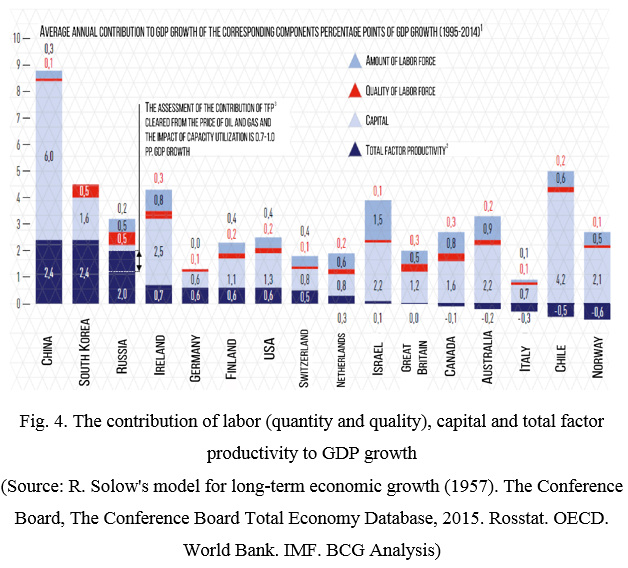
A significant increase in the total factor productivity in Russia in the period from 1995 to 2009 was primarily ensured by innovations in the financial sector, real estate operations, production of electrical, electronic and optical equipment, production of rubber and plastic products, textile and clothing industry, production leather products and footwear (see Fig. 5).
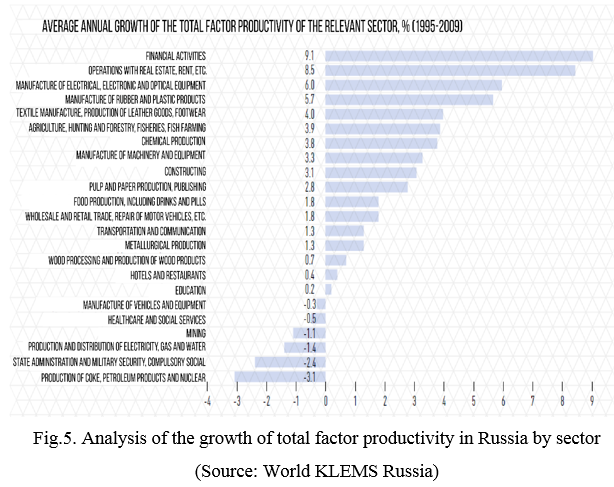
Thus, Russia has demonstrated a significant increase in total factor productivity in most sectors of the economy over the last 15–20 years, and a significant lag in the labor productivity indicates further opportunities for the long-term growth in the economic well-being.The pyramid of innovation development. For the growth and development of innovations in the country, it is necessary to have a favorable environment for scientists, entrepreneurs and innovators. This widely recognized and popular thesis is formulated in strategic documents of almost all countries that have reached a high level of an innovative development. The Russian state strategy of development, adopted in 2011, also pays a great attention to the topic of providing a favorable innovative environment.
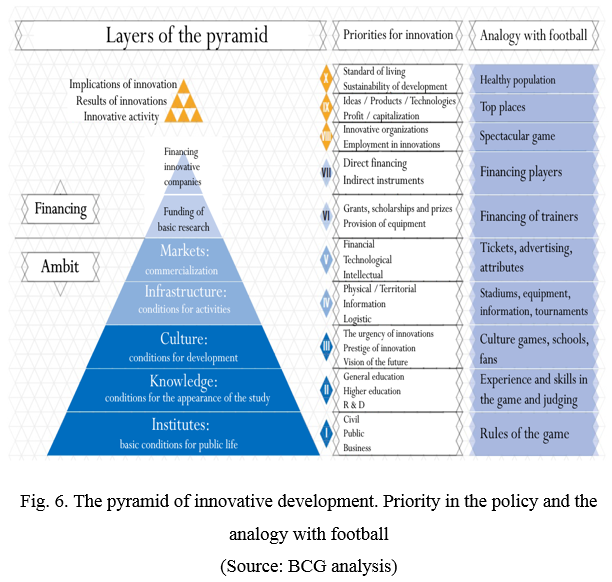
In this report we want to go a step ahead and, first, to reveal in more detail the very concept of the medium – to show what elements it consists of and how it is structured, and secondly, turn the thesis about the priority of a favorable environment into quantitative analytical tool that could be used in the policy of innovations. We propose to structure the concept of the environment in the form of a pyramid of an innovative development, or shortly – the pyramid of innovations. This pyramid, by analogy with Maslow’s pyramid, defines the hierarchical sequence of the needs of the innovations environment. These needs, in turn, determine the main blocks of state policy instruments and their priorities (see Fig. 6).
Please, also note that we have drawn an analogy between the theme of innovations and that of the football. You can find a column entitled “Analogs with football”. The football allegory will help to relate the highly specialized theme of innovations to the theme of the struggle for the world leadership in football, one way or another understandable to most of us, the football fever that has engulfed the world in recent decades looks like an innovative fever, no state can afford to stay away. In football, as in innovations, that player is good who does not only scores, but scores more than others, that team is good, which is not only famous for traditions or names, but wins in the current championships and the country cannot be considered a football country whose team has not participated in the final games of the world championship for a long time – whatever the circumstances. They prevented the game, but then how can we win the World Cup? We have seen different solutions all over the world, including inviting a dear foreign coach, giving citizenship and money to high-class foreign players. and so on, but no coach will teach a team that has no talented players, no legionaries will be able to firmly establish the country in the list of football powers, and the only way – difficult, long and ungrateful for current football functionaries – is to create good football traditions and facilities in the country, that is a favorable environment: infrastructure, schools, clubs, game culture, fans, related business. And to make it all better than in Brazil, Germany, Spain, Italy and so on.
In addition to providing a favorable environment, an important component of innovations policy is also to direct financial support for research and innovative projects. This type of policy is attractive for the state, because it is concrete, measurable, promises fast positive results and makes available a pool of “wards” to the state. Creating the environment is a long process, poorly structured and not having a specific recipe.
However, only by providing a favorable environment, the state can expect direct support to be effective. In this case, firstly, the projects themselves will appear that did not grow in the hostile environment, and secondly – the channels of an effective distribution of funds. Thus, if the principle of the pyramid is applied to the “environment” and “financing” blocks, the first one should be placed in the “foundation”, and the second – on the “upper floors” (see Fig. 6).
The state of innovations in Russia. The development of the innovative sphere in Russia can be divided into two stages. Until 2014, the state’s efforts were mostly aimed at creating basic elements of the innovative infrastructure, developing the professional competencies of the system’s participants, encouraging the development of new promising markets and supporting innovative projects, reorganizing the scientific sphere and developing state programs aimed at development of high-tech sectors of the economy. Now, there is a stage of rethinking the functioning of the current system. In the framework of the execution of the list of instructions D.A. Medvedev on the development of innovations from 09.08.14, the central projects for the development of the innovation system are increasing the efficiency of government bodies, promoting the development of companies with state participation and private business, further developing and increasing the efficiency of the system of research and development institutions. The priorities for the present time are the analysis of innovative programs of state-owned companies, the assessment of R & D institutions, investment in research and improvement of the R & D base (research, development and civil engineering work carried out by in the framework of a complex project), national projects with a high innovative components. Among the main results, there are the development of competences on the economic growth, the adoption of the Federal Law of December 29, 2012 No. 273-FZ “On Education in the Russian Federation” the launch of practice-oriented undergraduate (applied Bachelors ) programs, as well as dual education programs, oriented on training in the conditions of real production and taking into account modern professional standards.
The development of science (pyramid layer – knowledge) includes the implementation of the reorganization of state academies of sciences, the creation of the Federal Agency for Scientific Organizations, the Russian Science Foundation and the Advanced Research Foundation, the approval of the Program of the fundamental scientific research in the Russian Federation for a long period, the approval of the Forecast of scientific and technological development of the Russian Federation for the period up to 2030.
The infrastructure development (pyramid layer – infrastructure) consists of the development of state programs of the Russian Federation “Economic development and innovative economy”, “Development of science and technologies”, “Development of the industry and increase of its competitiveness”, “Information society” and a number of other government programs aimed at the development of high-tech sectors of the economy; forming a system of development institutions in the field of innovations, in particular, for the last five years, the creation of Skolkovo (2010), the Association of Innovative Regions of Russia (2010), the Fund for Infrastructure and Educational Programs (2010), the VEB- Fund Innovations ”(2011), Russian Direct Investment Fund (2011), Industrial Development Fund (2014), EXIAR OJSC (2014); adoption of a new version of the Federal Law “On Economic Partnerships”, which formulates an agreement on partnership management, within the framework of which necessary conditions and procedures for the creation of funds, including the implementation of venture investment, are determined.
The development of innovation territories (pyramid layer – infrastructure) means financing for the creation in the constituent entities of the Russian Federation of the infrastructure of innovative entrepreneurial activity. In the framework of the Support Program for small and medium-sized enterprises in the subjects of the Russian Federation for the period 2010–2015. 8.4 billion rubles were allocated for these purposes; formation of 26 pilot innovation territorial clusters, for the provision of subsidies which provide 1.25 billion rubles, the creation of a special economic zone “Innopolis”, the formation of a cost recovery mechanism for the creation of technology and industrial parks; implementation of pilot programs to stimulate the demand for innovative solutions at the regional level, one of the programs is “Innovative Procurement”, the goal of which is to increase the volume of procurement of effective solutions by companies with state participation.
The export development and international cooperation (pyramid layer – markets) embraces the formation of an export support system, including high-tech products in the “one-stop” mode, allowing Russian exporters and foreign buyers to electronically fill in and submit primary documents, the formation of mechanisms for cooperation in the field of innovations with the BRICS countries, organizing an open annual forum for all parties interested.
The development of innovative business (pyramid layer – financing of innovative companies) includes the creation of the Agency for Strategic Initiatives to promote new projects, the approval of the “roadmap” in priority areas of technological development, information technologies, photonics, the production of composite materials, biotechnology, engineering and industrial design, the introduction of innovative technologies in the fuel and energy sector, the approval of the innovative development program of 60 largest state-owned companies, the adoption of a sectoral plan for import substitutions in industry, the legislation on the best available technologies and the introduction of modern technologies has been predominantly formed [1, P. 231.]
Comparison of innovative development and the potential of Russia with the countries – leaders and “geeks” of innovation. To analyze the innovative development of Russia, we need an international base for a comparison. In order to get maximum information from such a comparison, we are interested in putting Russia on a par with the following groups of countries: with the countries that are leaders of innovations in order to know exactly what is good, what worked and works, with those ones similar to ours in size and structure of the economy, so that the conclusions are applicable, and with those ones included in the list of leaders relatively recently, so that the conclusions are relevant. We applied the following six criteria for selecting countries for comparison: current leadership in recognized international innovation development ratings (we took into account our position in the four largest innovation indices — the Global Innovation Index (GII), the Global Competitiveness Index (GCI), The Bloomberg Innovation Index (BII) and Forbes World’s Most Innovative Companies (FWMIC). In addition, we only considered OECD member countries and partners (40 countries altogether), because we want to compare Russia with economically developed countries). The market is up in the ratings, made over the past five years (for example, China made a spurt up by sixteen places in the GII index (from 43 in 2010 to 29 in 2015), Great Britain – 12 places, Ireland – by 11 places, Italy – by 7 places, the USA – by 6 places; Russia, by the way, made a breakthrough by 16 places – that is, more than all developed countries and BRICS countries. Our country showed an active participation in international trade in intellectual property. We take into account the trade turnover, that is, import plus export, based on the fact that countries with a greater turnover are included in the global innovative environment, the large size of the economy – nominal GDP in US dollars. This criterion allows us to choose for comparison with Russia only large-scale economies that have a corresponding set of problems that are not driven by small countries, including the manageability of the economic and financial system, often the size territories, population, etc., the three largest economies – the USA, China and Japan, Russia – on the 9th place, high level of economic development: nominal GDP in US dollars per capita, Russia – at a modest 58th place, a certain dependence of the economy on the rent received from the export of natural resources. We also selected three additional countries that were not included in the final list because of the aggregate of the previous selection criteria, but, nevertheless, interesting for us from the point of view of innovative development experience in conditions of the natural rent. These countries are Canada, Norway and Chile.
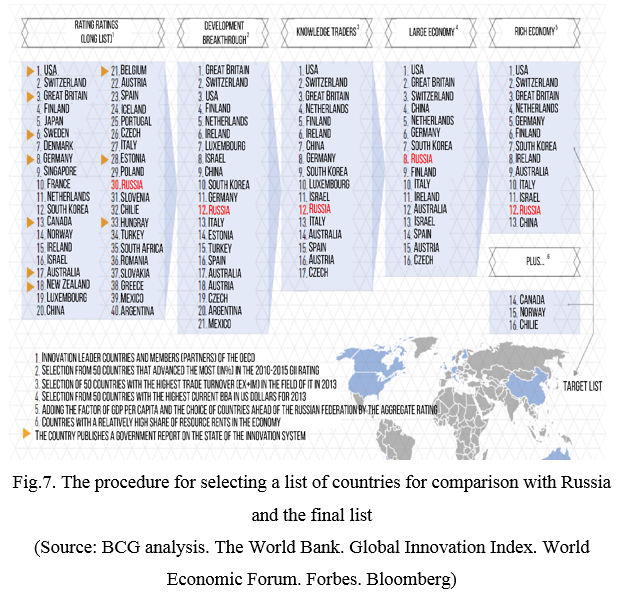
The selection procedure and the final list of countries are shown in Figure 7. In each subsequent list, the countries from the previous list change places and are partially eliminated, reflecting the accumulated rating on the totality of the criteria. The final list includes 15 countries for comparison – from the USA to Chile – and the list turned out to be prioritized, that is, the policy pursued in the United States is more interesting than the policy in Switzerland, Switzerland is more interesting than the United Kingdom, and etc.
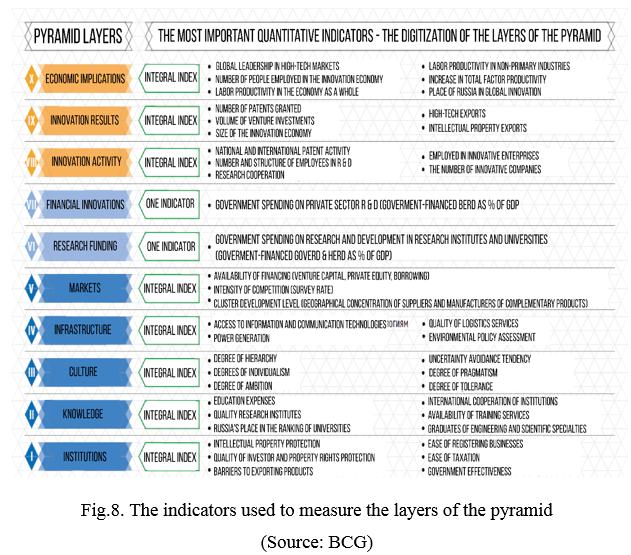
Such a technique allows to judge whether a state or a lot of resources are invested by the state in each of the layers of the pyramid, since this can be said only in relation to other countries. These results can be demonstrated in the form of a “heat map”, where top-down countries are the leaders of innovation (in descending order), and from right to left – the layers of the pyramid (from the foundation to the top), and the values are painted in the color range from green (“excellent”) to red (“losers” with twos and ones). Figure 9 shows the results for 15 countries of our target list and Russia.
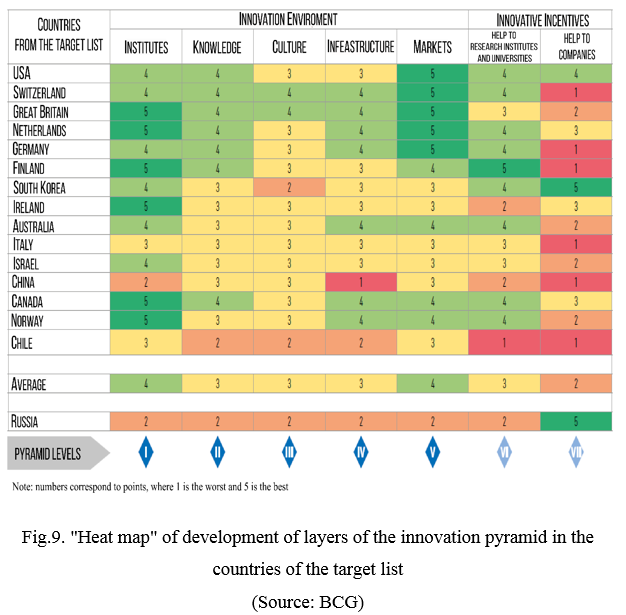
Each country has its own peculiarities, but in general the legitimacy is obvious: almost all countries of the targeted list are “excellent students” in the layers of institutions and markets, “good” in the layers of knowledge, culture, infrastructure and financing of fundamental research, but remain committed “losers” in the layer of financing commercial projects. That is, countries – leaders of innovation are leaders of the environment but are far from the top of the list in terms of financing commercial projects. Interesting exceptions are South Korea (“five” for state financing of commercial projects) and China (low marks for fundamental layers).
In Russia, which places in the ratings according to the relevant indicators are presented in the bottom line of the “heat map”, the situation is the opposite: our country is an absolute honored student of targeted state financing of commercial innovative projects, but at the same time has an un-innovative environment.
The main directions of innovative policy in Russia and innovations as a lever of influence on the economic well-being of the Russian Federation. Now innovations are the main possible lever of influence on the long-term growth of economic well-being for Russia, because the possibilities of the rest are significantly limited. In recent years, the basic elements of the national innovations ecosystem have been formed in Russia, the implementation of large-scale transformations continues, but it should also be noted that the results achieved do not meet expectations.
For Russia, in order to reach the world level of innovative development and compete with the leading countries, it is necessary to reform the current innovations policy, which must be carried out in accordance with the primary tasks: first, the main task is to optimize the innovations management system to improve the coordination of innovations politicians, secondly, the development of common agreed cross-cutting priorities of innovative policy, thirdly, the elimination of the reasons for the “openness” of the innovations system (in terms of increasing the return on R & D costs and increasing the quantity, availability and competitiveness of ideas and inventions), fourthly, the introduction of a unified monitoring system of the innovative system, including measures for detailing and introducing a system for monitoring innovations.
List of sources
- Balikhina N.V., Kosov M.E. Development of investment and innovation processes in the Russian economy. Financial aspect // M .: UNITY-DAN. – 2014. – P. 231.
- Economic Bulletin of Russia. 2006: Statistical collection / Ed. Col .: A.E. Surinov, I.A. Zbarskaya and others – Moscow: Rosstat, 2006. – P.561.
- Filimonov F.Yu. The genesis of innovation: the process of the emergence and development of innovation // Industrial service. – 2015. – № 2 (55). – P. 194-200
- Foreign trade of the Russian Federation: Statistical compilation: 2007. – M .: Central Bank of the Russian Federation, 2008. – P.282.
- Gershchenkron A. “Economic Underdevelopment in the Historical Perspective” (“Economic Backwardnessin Historical Perspective”) – // 1962 – // P.121-155
- Nekrasov D.A. The development of the theory of innovation. Innovation cycles // Bulletin of the Samara State University of Economics. – 2010. – № 5 (91). – P. 68-71.
- Osipov Yu.M. On innovations in general and innovations in modern Russia // Philosophy of Economics. – 2008. – № 3 (57). – P. 253-255.
- World Bank: Statistical Book. – M .: World Statistics, 2012. – P.342-343.


